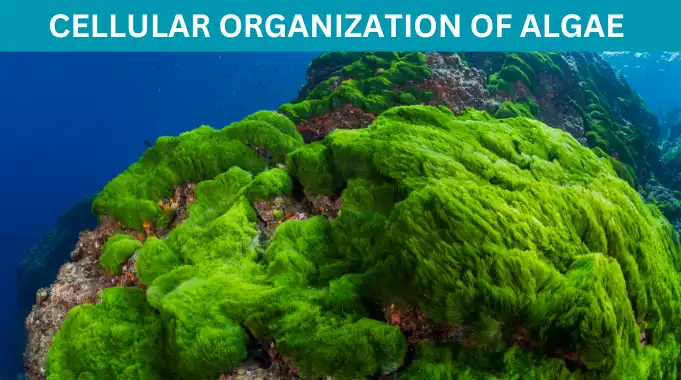Algae display a unique range of cellular structure and complexity. From prokaryotic cyanobacteria to eukaryotic seaweeds, algal cytology spans simple undifferentiated cells to advanced compartmentalized cells containing specialized organelles.
Understanding algal cell biology provides key insights into their evolution, taxonomy, physiology, and adaptations to aquatic and terrestrial environments.

Prokaryotic Algal Cells
The most primitive algal cells occur in the cyanobacteria, formerly called blue-green algae. Cyanobacteria possess prokaryotic cells lacking membrane-bound organelles like mitochondria, chloroplasts, Golgi bodies, and endoplasmic reticulum.
Their DNA exists as a ring-shaped chromosome in the nucleoid region rather than within a true nucleus. As prokaryotes, cyanobacteria cannot undergo mitosis or meiosis. They reproduce asexually by cell division or fragmentation.
Cyanobacteria likely represent one of the earliest evolutionary branches of photosynthetic life, developing oxygenic photosynthesis before the rise of eukaryotes. Features of their simple cells reflect this ancestral position.
Despite the absence of organelles, cyanobacteria contain specialized structures for optimized photosynthesis.
Thylakoids, photosynthesis, and electron transport sites exist as unstacked membranes distributed throughout the cytoplasm rather than sequestered in chloroplasts.
Phycobilisomes attach to the thylakoids and absorb light energy, passed to chlorophyll molecules. A strong peptidoglycan cell wall provides structural support.
Among prokaryotes, cyanobacteria are unique in their ability to carry out oxygenic photosynthesis using water as an electron donor. This requires the oxygen-evolving photosystem II.
Their cells also contain inclusions like glycogen granules, carboxysomes containing rubisco, and cyanophycin protein reserves. Gas vesicles provide buoyancy.
Eukaryotic Algal Cells
All other algae possess eukaryotic cells containing membrane-bound organelles like nuclei, mitochondria, chloroplasts, and an endomembrane system. These allow the compartmentalization of biological processes within specialized organelles.
Complex multicellularity is only possible with eukaryotic cellular organization. Motile eukaryotic algal cells often utilize flagella, anchored by basal bodies, for locomotion.
Flagella exhibit a characteristic “9 + 2” microtubule pattern, with nine outer doublet microtubules surrounding two inner microtubules.
Many also bear mastigonemes, tripartite tubular hairs that project sideways to enhance thrust. Flagella confer critical advantages for accessing light and nutrients.
Cell Coverings
Unlike land plants, most algal cells lack rigid cellulose walls. Algal cell coverings range from thin cellulose walls to flexible proteinaceous pellicles. Cell walls help maintain cell shape and internal turgor pressure while protecting against external stresses. Composition varies between major algal groups.
For example, green algae produce walls containing cellulose and glycoprotein. Red algal cell walls have agar or carrageenan in their galactan matrix. Brown algal walls contain alginic acid and sulfated fucans like fucoidin. Diatom cell walls are silicified with ornate nanopatterns. Some algae have scales, coccoliths, or a multilayered theca rather than a cell wall.
The plasma membrane immediately surrounds the cytoplasm of all algal cells. In “naked” cells lacking walls, the plasma membrane constitutes the entire outer boundary. It controls selective passage of molecules and ions between the cell and environment. The plasma membrane utilizes phospholipids, proteins, and carbohydrates.
Cytoplasm
The cytoplasm comprises the interior contents of algal cells, excluding the nucleus. It provides the aqueous medium necessary for biochemical reactions and molecular transport within the cell.
Major cytoplasmic components include mitochondria, chloroplasts, golgi bodies, endoplasmic reticulum, vacuoles, cytoskeleton, ribosomes, and inclusions.
Soluble enzymes catalyze key metabolic pathways in the cytoplasm, such as glycolysis, the pentose phosphate pathway, the Calvin cycle, and the citric acid cycle. Cytoskeletal elements like microtubules facilitate organelle positioning and intracellular transport.
Vacuoles take part in osmoregulation and storage. The cytoplasm is in constant oscillation.
Chloroplasts and Chromatophores
The defining organelles of algal cells are the chloroplasts and chromatophores that carry out photosynthesis. Various groups exhibit different pigment compositions and thylakoid arrangements suited to their light environments. chloroplasts are chloroplasts containing chlorophyll a and b, while chromatophores lack chlorophyll b.
The common architecture involves stacks of thylakoid discs enclosed by an envelope membrane. Photosynthetic light harvesting takes place in the thylakoids. Stromal spaces contain DNA, ribosomes, and enzymes mediating carbon fixation. Pyrenoids represent specialized sites for concentrating CO2 near rubisco.
In red algae, thylakoids remain unstacked in the chromatophores. Brown algae have bands of 2-4 thylakoids instead of stacked grana. Most chloroplasts contain 3-6 thylakoids per stack and 1-2 pyrenoids. Chloroplast structure matches functions like light harvesting, photochemistry, and carbon fixation to the environment.
Eyespots
Eyespots are photoreceptive organelles allowing algae to orient towards or away from light. A classic eyespot comprises a platelet of carotenoid globules underlying the chloroplast envelope. Adjacent thylakoids connect the eyespot to the chloroplast lamellar system.
By shading part of the chloroplast from light, the eyespot creates directionality for phototaxis and positioning. It may also regulate photo cycling. The ancestral eyespot type comprises osmiophilic lipid droplets associated with thylakoid membranes. Advanced eyespots feature crystalline photoreceptor arrays.
Mitochondria
As sites of cellular respiration and ATP synthesis, mitochondria are fundamental eukaryotic organelles found in all algal cells. Their double membranes enclose a matrix containing mitochondrial DNA, ribosomes, and enzymes of the citric acid cycle, beta oxidation, and oxidative phosphorylation.
The inner membrane is highly convoluted, forming cristae folds that house the multi-protein enzyme complexes mediating electron transport and ATP generation. Cristae development reflects the aerobic activity and respiratory demand of different algal cells. Mitochondria undergo fission and fusion dynamically.
Nucleus
In eukaryotic algae, the genetic material within membrane-enclosed nuclei. The nuclear envelope contains many nuclear pore complexes regulating transport into and out of the nucleoplasm. It envelops condensed chromosomes of linear DNA-protein complexes during cell division.
The nucleus governs cellular activity through ribosome biogenesis, DNA replication, and transcription into RNA. It provides the instructions dictating growth, metabolism, and reproduction. Cycling between chromosomes and chromatin allows gene expression changes and epigenetic regulation. The nucleus is the control center.
Endo membrane System
Eukaryotic algae possesses an endo membrane system of organelles involved in secretion, enzymatic synthesis, and transport. These include the endoplasmic reticulum, Golgi apparatus, lysosomes, vesicles, and vacuoles enclosed by lipid bilayers.
The endoplasmic reticulum (ER) forms an interconnected network of flattened discs and tubules extending throughout the cytoplasm. Ribosomes studding the ER translate mRNAs into new proteins destined for secretion or inclusion in membranes. Golgi bodies process and package these proteins into transport vesicles.
Golgi stacks mediate the post-translational modification of proteins and lipids, especially glycosylation. Vesicles and vacuoles carry out storage and intracellular transport roles. The endo membrane system coordinates the distribution of metabolites and macromolecules within the cell.
Pigments and Reserves
Algae produce a remarkable diversity of photosynthetic pigments localized in the chloroplasts and chromatophores. These include chlorophylls, carotenoids, and phycobiliproteins. Accessory pigments like fucoxanthin in diatoms expand absorbable light spectra.
Food reserves are fundamental to algal cell function. Storage products like starch, oils, and carbohydrates like laminarin sustain metabolism in light-limited environments. Floridoside and mannitol are common soluble reserves. Inclusions contain polymers of carbon, nitrogen, and phosphorus compounds synthesized when nutrients exceed growth requirements.
Inclusions take the form of distinct cytoplasmic granules and globules. They accumulate vital reserves that can be mobilized to support reproduction, mitosis, and survival during prolonged darkness or nutrient starvation. The composition and quantities of photosynthetic pigments and storage inclusions distinguish algal taxa.
Cytoskeleton
Algal cells rely on cytoskeletal elements like microtubules and actin filaments to control morphology, transport, locomotion, and chromosome separation. Microtubules arrange the spindle apparatus, segregating chromosomes during mitosis and meiosis.
Flagellar basal bodies contain cylindrical arrangements of microtubule triplets from which the flagellar axoneme extends. Microfilaments form contractile networks, enabling changes in cell shape. Intermediate filaments reinforce cell strength. Together, cytoskeletal components facilitate essential cellular processes.
